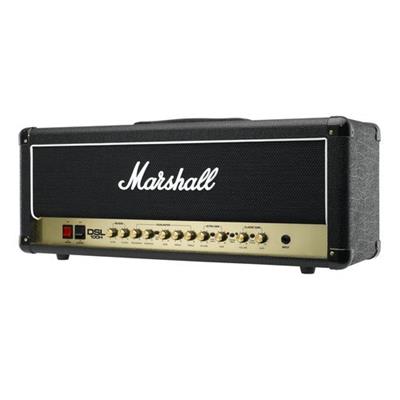| Build Quality: |  |
| Hardware: |  |
| Electronics: |  |
| Sound: |  |
| Value: |  |
| Average: |  |

Pros:
- Sounds like a classic Marshall amp
- Delivers versatile tones
- All tube circuitry
- Adjustable power allows you to use it anywhere
Cons:
- Ultra Gain channel is not everybody’s cup of tea
- The reverb is not the best
Sometimes I sit down and start thinking about the scenarios that could have changed everything. What would have happened if tube amplifiers had never been invented? What if the only existing amplifiers were solid-state? These questions cannot be answered simply, there can be many variations depending on how you look at the subject. However, one thing is clear – we would be deprived of the opportunity to work with amazing sounds and would never taste the warmth and sweetness of the valves. Luckily, tube amplifiers do exist and they provide us with spectacular possibilities. There are many staples in the world of valves and one of them is definitely Marshall. Their newer DSL series features a DSL100H head, which has a lot to offer and is one of the best tube amps out there. If you want to see what this bad boy does, just keep on reading!
Features
DSL100H does not offer anything unworldly or too innovative. Everything it offers is basically well-known classics, however, those classics are what get the job done and give you amazing results. This amp head has 100 watts of power output that can be bisected. This allows you to utilize only 50 watts and explore the tones that the smaller power can deliver. DSL100H is comprised of high-quality valves: it has four ECC83 tubes in its preamp section and four EL34 tubes in the power-amp section.
This amplifier has two channels: Classic Gain creates shimmery pristine tones and can be broken up in the style of the Marshall JCM800 amp, while the Ultra Gain takes the distortion to a whole new level and offers a significant amount of gain. Both channels have two modes – Classic Gain can be utilized in Clean/Crunch modes, and Ultra Gain operates in OD1 and OD2 modes. Apart from distortion, DSL100H offers onboard reverb and the effects loop, which allows you to pair this unit with your favorite effects pedals. This amplifier is compatible with the foot controller (included in the package), which allows you to control the device on the fly. DSL100H has a single ¼” input for your instrument, a single 3.5mm auxiliary input, MIDI in, and the socket for the footswitch. It has five ¼” speaker outputs and a single ¼” emulated line out.
Controls
Marshall once again decided to sort everything beautifully and created small sections with a couple of knobs. Each of the sections is labeled, so that you know what each control takes care of. This reduces the chance of unexpected mistakes and makes sure that everything is perfect. I will try to describe the functionalities of each knob and provide you with the information you will need for tweaking this baby.
Even though this might seem like explaining things backward, it is better to start discussing the knobs starting from the input. The classic Gain section has three controls: Gain adds an extra “oomph” to your sound and gradually distorts it, Volume sets the level of this channel, while the Clean/Crunch selector allows you to choose between the named modes (there is a LED which indicates which mode is selected). Ultra Gain channel has the same exact controls, the only difference is that you choose between OD1 and OD2 modes instead of Clean and Crunch. Then comes the EQ section.
Treble, Middle, and Bass act as your typical tone controls; Tone Shift reconfigures the EQ of the preamp and adds a new dimension to it; Presence and Resonance attenuate the higher and lower frequencies respectively, independent from the rest of the tone-shaping controls. Next comes the Reverb section: Reverb Classic takes care of the reverb generated by the Classic Gain channel, while the Reverb Ultra is employed with the Ultra Gain channel. Master Volume has Master 1, Master 2, and Master Select (allows you to choose either Master 1 or Master 2), which set the overall level of the amplifier. Towards the end, there is a Loop On/Off which turns the effects loop on and off. And finally, we have the Power and Output. The former turns the device on and off. The latter has three settings: High activates 100 watts, STB (standby) keeps the tubes warm when you switch off the unit, and Low triggers the bisected power, i.e. 50 watts.
Marshall DSL100H Sound
When it comes to sound, a lot can be said about the DSL100H. Just think carefully, it has two channels, each diversified with two modes. As you would probably guess, what you get here is an extremely versatile tone. The Classic Gain channel delivers punching clean tones, with a lot of presence, defined midrange, and accentuated highs or resonating lows (depending on the settings you choose). As you turn up the gain knob, your signal starts to break up and bark up some badass, crunchy overdrive. The Ultra Gain channel is a completely different story. Though it might not be useful for everyone, it can change your sound significantly and add a lot of gain to it. The main thing here is to tweak it properly. The digital reverb on this one is okay, but you will probably receive better results if you use the badass reverb pedal. DSL100H offers an extensive set of sounds that can be further expanded with the FX loop.
Conclusion
Let’s be honest, DSL100H is not without faults. Yes, it has some flaws but all the musical devices do. To make up for it, it can create jaw-dropping sounds and deliver the loudness that will tire out all your teammates (even the drummers). To wrap things up, I will just say that Marshall DSL100H is definitely worth a shot. Just try it out and explore all of its possibilities. After all, the final judgment is yours to make. Good luck!






